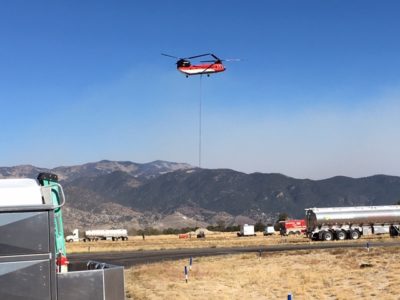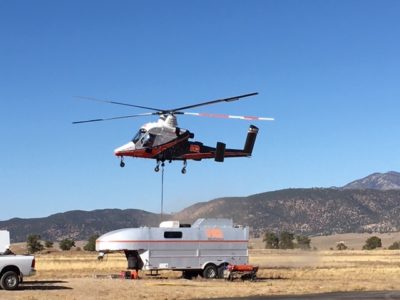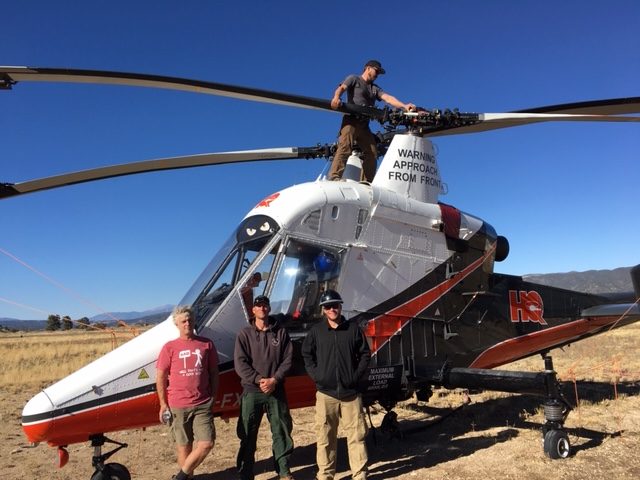Throughout this week, helicopter firefighting crews have continued their aerial assault on the Decker Fire, even as unstable weather over the fire area contributed to shifting wind patterns, red flag wind warnings and volatile humidity. Those conditions have not stopped the effort of the Decker Fire Flight Command, which includes eight aircraft flying out of the Salida Airport,
A visit to the airport found it buzzing with activity, with flights departing and arriving, and the lounge area of the Salida Airport terminal filled with pilots, many pouring over large maps of the fire. They come from across the country; one of the pilots, Mike Bristol, with an air traffic group in from Alaska.
Pilots and flight crews work a 36-hour week, and eight-hour days, carefully monitored so that fatigue and stress don’t overtake the crews, and helicopters and equipment can be safety-checked.

A Chinook helicopter lifts off from Salida Airport with long line attached, carrying a full load of water to a designated drop site to support ground operations. Photo by Jan Wondra.
“We’ve got those heavies, dropping both water and slurry (fire retardant) coordinated with what is going on at the fire lines” said the head of ground operations Michael Garcia, in charge that day of what is called “the deck” of air operations.
The large planes have come down from the metro Denver area, drop their loads and then loop back to the Front Range.
That leaves the aircraft positioned locally for immediate operations. “They include a Chinook, a Blackhawk and a K-Max; they’re our work horses,” said Garcia. “We’ve also got a Type 2, and two Type 3 helicopters, and two fixed wing aircraft, each used for different purposes and conditions.”
Asked how much they could carry, Garcia explained “How much any of these can carry in a load, how high and how far, depends upon the conditions; the wind speed, the humidity and what elevation are we sending them into.”

Deck Leader of Flight Ground Operations Michael Garcia explained the various types of aircraft with a role fighting the Decker Fire. Photo by Jan Wondra.
The Chinook, a turbine, two-blade, heavy lift helicopter, is the biggest helicopter at Salida Airport right now. It’s what Garcia referred to as “The workhorse – it’s been in use since Vietnam and sometimes it’s called a Huey. It’s got two pilots, it’s basically a cargo -delivery machine, meant to carry cargo, people, fire fighting supplies. It’s got a snorkel that can pick up and deliver water and fire retardant. Just this morning it flew two 40-person hot shot crews into position.”
As we talked, helicopters were taking off and landing. The crews explained that one helicopter is always on hand at the airport for emergencies.
A Type 3 helicopter landed and Garcia explained that it was a more tactical craft “intended for quick response, small fires and hot spots, where it could be used for short-haul, initial attacks.” They often come in with medics, who can be dropped in with long-lines to evacuate an injured fire fighter, then fly out.
“It’s a unique tool,” said Garcia. “We identify points on the mountain where they can be landed safely to drop off or fly out people or equipment. We call those areas heli-spots. This craft here is made especially for high altitude fire fighting.”
As we talked, a K-Max crew flew in, returning from its 21st mission of the day; each trip dropping water from a 660 gallon bucket tethered below the craft.
The K-Max, also a Type 1 fire fighting craft, is an unusual-looking, but extremely efficient helicopter. It’s narrow nose is only large enough for the pilot, giving the pilot an unimpeded view of his drop lines, combined with high maneuverability. It has two double overhead blades, but no rear rudder blades, and carries 1,450 lbs. of fuel.
The $8 million K-Max, says pilot Brian Nelson, “Is special. It weighs 5,300 pounds and it can haul 6,000 pounds. The composite blades are made of Sitka Spruce and the whole craft is made in the U.S.A. It’s highly maneuverable and accurate, made so I can see my tow lines.”

The K-Max aircraft comes in for a landing after its 21st mission of the day, dropping water on the Decker Fire in 660 gal. drops. Photo by Jan Wondra.
“The water being used to fight the Decker Fire is coming from a variety of sources, explained K-Max crew member Andre Evans. “We are using water from the Arkansas River, from lakes and ponds, from Bear Creek. But we don’t just take it – there are contract agreements and we track what we take and we put that much water back. We decontaminate buckets between water drops from different sources. We don’t mix species and our process keeps the slurry out of the water supplies.”
The helicopter missions cover a wide range of firefighting duties. Just Monday morning, helicopters delivered two hot shot crews, around 40 personnel in each crew, to high firefighting positions to continue building direct fire lines. Another smaller craft flew Chaffee Sheriff John Spezze on a ground review to identify trigger points in case more evacuations might be needed.”
A conversation with the Supervisor of Flight Operations Sonya Straka, revealed the close collaboration between ground and air crews, based both on training and the structure of collaborative agreements among the fire commands.
“We’ve all trained for this, so we know how to work together in teams,” said Straka, from Ft.Collins. “Even if we’ve only just met the people we’re working with, it’s cohesive. We’ve all been trained the same way. And that training, by the way, means that every decision we make is weighed as risk versus benefit – is what we’ll gain, worth the risk – to crew, to equipment, to our safety standards.”
Straka explained that within the next few days, Incident Command hopes to implement a burn plan covering about 1,500 acres. “It’s carefully planned. We’ll drop plastic sphere dispenser devices (PSD) to clear fuels between the fire’s edge and Rainbow Trail, so the fire can’t endanger structures below. But all the conditions have to be just right.”
As we talked, the weather report from the Meteorologist Aviva Braun came in on radios, indicating a move to a red flag warning. Straka began a roll call of all her helicopter teams working the fire, asking them to each confirm they heard the message.
“When we go to red flag warning, we leave it up to the pilots to make the decisions on whether these are conditions they can confidently continue to fly in,” said Straka. “It’s based on their aircraft, the weather conditions, the terrain, the weight they’re carrying.
The emphasis on safety and training, is just as obvious with the flight crews as it is at the Decker Fire Camp set up at the Chaffee County Fairgrounds. “ We have to say kudos to the local fire crews and the people here. They have been great,” said Decker Fire Public Information Officer Rick Barton. “Once we’re here, we’re all on the same team.”
Cover photo: K-Max crew left to right: Pilot Brain Nelson, Andre Evans, Medic Morgan Oldenburg and atop the K-Max; Brent King, Fuel service driver. The team hails from Los Padre National Forest in California. Photo by Jan Wondra.
Decker Fire Information Office
Fire Info Line: (719) 626-1095
InciWeb: https://inciweb.nwcg.gov/incident/6592/
Facebook: facebook.com/DeckerFire2019








Recent Comments